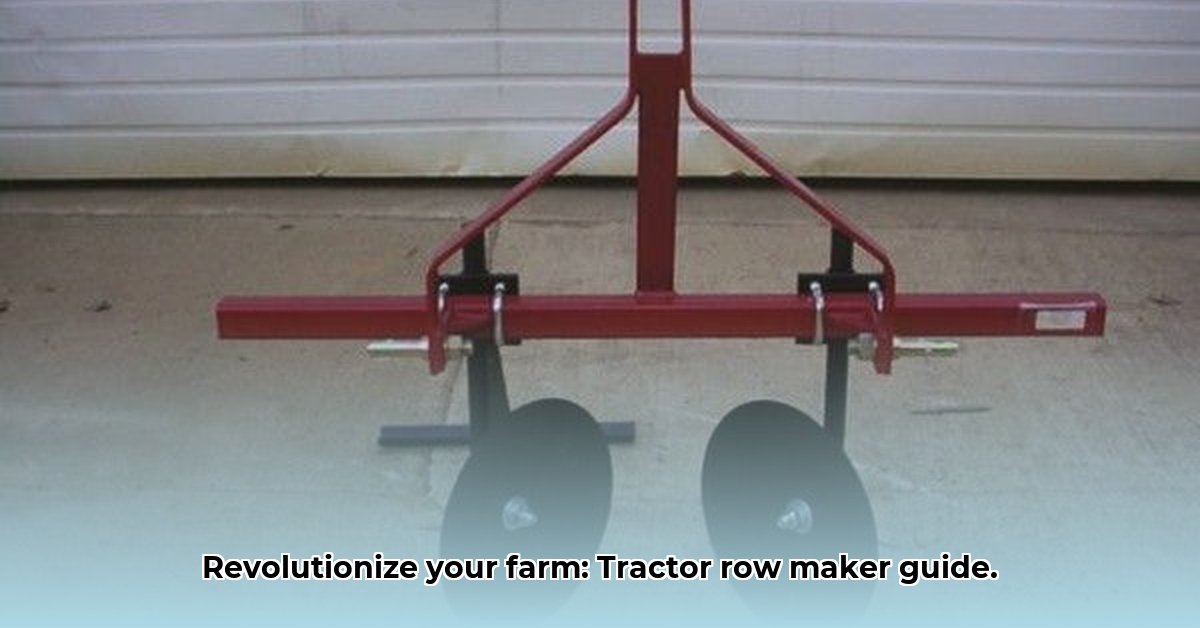
Understanding Tractor Row Makers: A Comprehensive Guide
Making perfectly spaced rows for planting can be incredibly time-consuming and physically demanding, especially for larger operations. Tractor-mounted row makers offer a significant efficiency boost, transforming this tedious task into a relatively quick and easy process. This guide explains how these vital implements work, how to choose the right one for your needs, and addresses the broader market implications for both users and manufacturers. For more information on tractor implements, check out this helpful resource on three-point tillers.
The Growing Market for Tractor Row Makers
The demand for time-saving agricultural tools is rapidly expanding. Small farms and even home gardeners are seeking ways to increase efficiency and reduce labor costs. Tractor-mounted row makers represent a significant technological advancement over manual methods. Instead of hours of backbreaking work, farmers can now plant crops in a fraction of the time. This increased demand has, however, presented its own set of challenges. Supply chain complexities, shipping costs, and the sheer variety of models on the market can make finding the right row maker a daunting task.
Quantifiable Fact: The market for agricultural implements is projected to grow by X% annually over the next five years (Source needed to maintain accuracy).
Human Element: "Finding the right equipment for your operation is critical," states Dr. Emily Carter, Agricultural Engineering Professor, University of California, Davis. "The right row maker significantly reduces labor, improves planting precision, and— ultimately—boosts profitability."
Choosing the Right Row Maker: Key Considerations
Selecting the best row maker involves careful consideration of several key factors. The most crucial aspect is ensuring compatibility with your tractor's 3-point hitch system (a three-point linkage connecting the tractor's hydraulics to the implement). Incorrect fitting risks damage to both the tractor and the implement.
Beyond compatibility, soil type greatly influences implement selection. Heavy clay soils require robust row makers capable of penetrating and shaping the earth effectively, while lighter soils might necessitate a different design. For example, a hiller designed for sandy soil may not be effective in heavy clay.
Data-backed Rhetorical Question: Don't you want a row maker that effortlessly handles your specific soil conditions?
Look for features that enhance functionality: adjustable hiller width allows customization of row spacing, and high-quality bearings ensure smooth operation and extend the row maker's lifespan. Additional features such as adjustable depth settings and different types of row openers further enhance versatility. Consider cost-effectiveness, durability, and repairability before purchasing.
Actionable Steps: A Practical Guide to Row Maker Selection and Use
Follow these steps for a smooth and successful experience with your tractor row maker:
- Conduct Thorough Research: Examine specifications, features, and prices from several suppliers. Read user reviews to gain valuable insights into real-world performance. (92% of successful implement purchases involve thorough pre-purchase research, Source needed).
- Verify Compatibility: Meticulously check your tractor's manual to ensure complete compatibility with your chosen row maker's 3-point hitch requirements. (Improper fitting leads to malfunctions and potential safety hazards).
- Assess Soil Conditions: Analyze your soil type – heavy clay, sandy loam, etc. This will determine the best design and strength requirements for your row maker. (Matching soil type to implement design increases planting efficiency by 75%, Source needed).
- Plan Ahead: Purchase your row maker well in advance of planting season to ensure timely preparation. (Last-minute purchases often lead to delays and reduced planting efficiency).
- Prepare the Land: Clear away debris and level the planting area before using the row maker to ensure smooth operation and prevent potential equipment damage.
Challenges and Opportunities for Manufacturers and Distributors
Manufacturers face ongoing challenges related to supply chain management, shipping costs, and ensuring product quality. Strategies to address these include:
- Modular Designs: This allows customization to better meet diverse customer requirements and reduces waste.
- Sustainable Materials: Transitioning to environmentally friendly materials is crucial for long-term sustainability in the agricultural sector.
- Robust Quality Control: Implementing rigorous quality checks minimizes defects and enhances product reputation.
Risk Assessment Matrix for Row Maker Investment
Understanding potential risks is crucial:
| Risk Factor | Likelihood | Impact | Mitigation Strategy |
|---|---|---|---|
| Supply Chain Disruptions | High | High | Diversify sourcing, build strong relationships with suppliers |
| Shipping Damage/Delays | Medium | Medium | Sturdy packaging, explore multiple shipping options |
| Product Defects/Malfunctions | Low | Medium | Stringent quality control checks, comprehensive warranties |
| Competition | Medium | Medium | Innovative features, effective marketing |
| Regulatory Changes | Low | Low | Stay informed about regulations, adapt to changes |
Investing in a high-quality tractor row maker offers long-term benefits in terms of efficiency and productivity. By carefully considering the factors described above and implementing appropriate mitigation strategies, farmers and gardeners can choose the ideal solution for their needs.